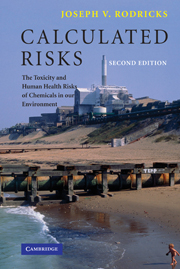Book contents
- Frontmatter
- Contents
- Preface to the first edition
- Preface to the second edition
- List of abbreviations
- Prologue
- 1 Chemicals and chemical exposures
- 2 From exposure to dose
- 3 From dose to toxic response
- 4 Toxic agents and their targets
- 5 Carcinogens
- 6 Identifying carcinogens
- 7 Risk assessment I: some concepts and principles
- 8 Risk assessment II: applications
- 9 Risk assessment III: new approaches, new problems
- 10 Risk assessment IV: the courtroom
- 11 The management of risk
- 12 A look ahead
- Sources and recommended reading
- Index
10 - Risk assessment IV: the courtroom
Published online by Cambridge University Press: 25 August 2009
- Frontmatter
- Contents
- Preface to the first edition
- Preface to the second edition
- List of abbreviations
- Prologue
- 1 Chemicals and chemical exposures
- 2 From exposure to dose
- 3 From dose to toxic response
- 4 Toxic agents and their targets
- 5 Carcinogens
- 6 Identifying carcinogens
- 7 Risk assessment I: some concepts and principles
- 8 Risk assessment II: applications
- 9 Risk assessment III: new approaches, new problems
- 10 Risk assessment IV: the courtroom
- 11 The management of risk
- 12 A look ahead
- Sources and recommended reading
- Index
Summary
In the 1970s, not long after the discovery that the synthetic estrogen DES could cause a rare form of vaginal cancer in young women exposed in utero, lawsuits on behalf of the victims began to be filed in federal and state courts, seeking payment for medical damages from the manufacturers of the drug. In the same time period similar lawsuits began to be filed on behalf of individuals who believed they had been harmed by exposure to asbestos. Veterans of the Vietnam War began, in the early 1980s, bringing similar suits against manufacturers of a herbicide mixture called Agent Orange that had been used widely and intensively by the US military to clear forests in Vietnam. Many veterans claimed that the massive spray applications of the herbicide, which contained low levels of dioxins, caused them to experience harmful exposures, and that they and their offspring suffered a range of serious diseases as a result. Although such lawsuits existed prior to the 1970s and 1980s, the three involving DES, asbestos, and Agent Orange initiated the age of the “mass tort,” and it continues to this day.
Legal rights
Under our laws individuals have the right to bring lawsuits against parties whose actions they believe have caused them harm. Harm (a “tort”) can come in many forms, but here we are concerned with harm that may have been caused by a chemical (a drug or a consumer product, for example) or by exposure to a chemical contaminant in the environment.
- Type
- Chapter
- Information
- Calculated RisksThe Toxicity and Human Health Risks of Chemicals in our Environment, pp. 273 - 281Publisher: Cambridge University PressPrint publication year: 2006



